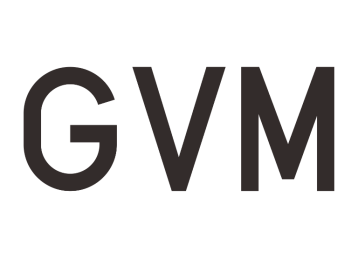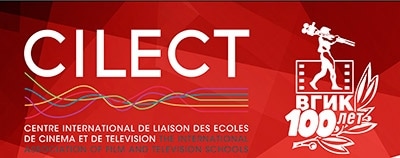
Text by Tony Costa
IMPRESSIONS FROM THE LAST VISIT TO MOSCOW
CILECT CONGRESS
Since October many weeks have already passed since my visit to Moscow. But still remains a fresh memory, despite being busy with many other IMAGO activities. Only now there is some time to remember and report the visit to VGIK and to RGC headquarters in this website. The motive that took me to Moscow was the CILECT CONGRESS which took place in Moscow between 6 and 12 of October. The congress was held on the occasion of the 100th anniversary of the world’s oldest film school VGIK (The Russian Federation State University of Cinematography named after S.A. Gerasimov).
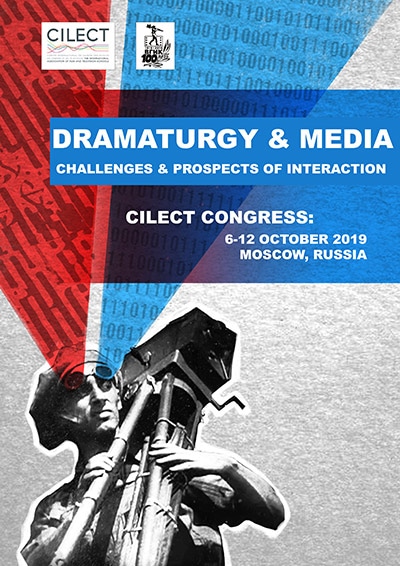 My presence in the CILECT congress was due to the fact that I am actually pursuing a PhD degree with a thesis work on cinematography and I have submitted a paper which was accepted to present during the Congress.This work has been going on for already three years and is based in practical essay called «One Film, Three Visions». This essay was shot in HFF Munich Film school whre 3 cinematographers Roberto Schaefer ASC , Axel Block BVK and Nina Badoux have shot all direted by Ilse Hofmann and produced by Katrin Richthofer, which as soon as possible I will make it publicly for consultation and use for my fellow teachers and colleagues in these pages.
My presence in the CILECT congress was due to the fact that I am actually pursuing a PhD degree with a thesis work on cinematography and I have submitted a paper which was accepted to present during the Congress.This work has been going on for already three years and is based in practical essay called «One Film, Three Visions». This essay was shot in HFF Munich Film school whre 3 cinematographers Roberto Schaefer ASC , Axel Block BVK and Nina Badoux have shot all direted by Ilse Hofmann and produced by Katrin Richthofer, which as soon as possible I will make it publicly for consultation and use for my fellow teachers and colleagues in these pages.
This was my first time attending a CILECT conference. For those who don’t know CILECT is the federation of Higher Education film schools from all over the world. The International Association of Film and Television Schools (Centre International de Liaison des Ecoles de Cinéma et de Télévision – CILECT) was founded in Cannes, France, in 1954. The association declared as its main aim the coordinated cooperation between the above institutions and the improvement of education via inter-institutional exchanges of knowledge and experience. Today represents about 180 educational institutions from 65 countries on 6. The federation is divided in different counsels by region as displayed below:
CAPA – (Asia-Pacific Association) is the regional association of the CILECT member schools in the Asia-Pacific Region.
CARA – (African Regional Association) is the regional association of the CILECT member schools in the African Region.
CIBA – (Ibero American Association) is the association of CILECT film and television schools in the Central & South American Region as well as in Mexico.
CAN – ( North America) is the association of CILECT schools in the North American Region.
GEECT ( European Grouping of Film and Television Schools) is the association of CILECT’s European members as well as schools in Israel and Lebanon.
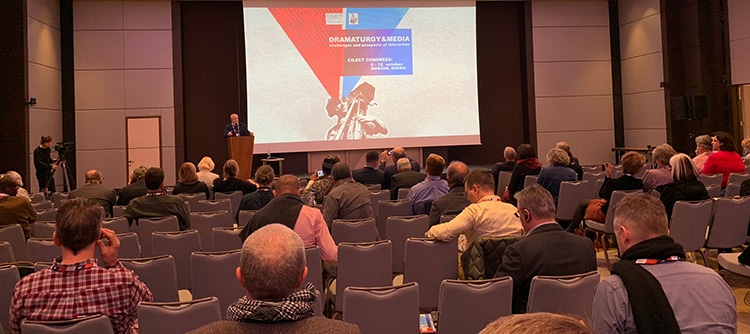 |
| The main conference Hall |
During the Congress these regional associations get together and held their general annual assembly. This organization is maybe something for IMAGO to look forward to in the future as an internal organizational system of representation. Once IMAGO has become International and more and more societies are becoming members it is probably a solution that should be taken into consideration in order to get societies more involved and this way more active, shortening the distance gap. There is another aspect that should be also looked at is the cultural differences from continent to continent and the diversity. A fact that enriches our federation.
CILECT also gives awards. Every year is distributed to all member schools works done by students from the various members in thje categories of documentary, animation and fiction totalizing more then a 100 films.
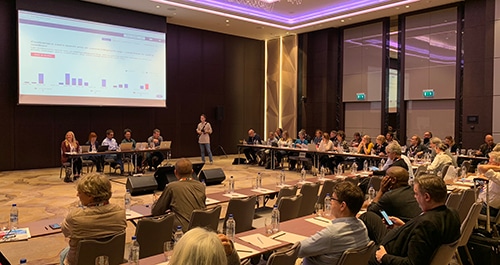 |
| GEECT General Assembly |
This edition of CILECT congress was focused in – Dramaturgy & media challenges & prospects of interaction. «The contemporary media culture over the past few decades resulted in the development of a new information-oriented society shifting from periodicals to cinema, television, and online news media and on to the new media and mobile applications. In this changing context a major role is played by the Internet which expands the media culture universe not only by enriching the capabilities of one-way communication but also by establishing quite a new form of dramaturgy – a dialogical, an interactive one» This was the theme in discussion during the congress.
The rapidly developing film and television industries needs the outmost attention from schools institutions. Presently, this involves the development of novel combined strategies and educational programs which will train experts capable of working efficiently with different media forms evolving within the industry. This is one of the main task of contemporary education. Some of the key speakers have addressed the difficulties of the number of films at people’s disposal and the frenetic viewing that doesn’t allow a more contemplative experience by watching films. Yuri Arabov Russian writer and poet addressed the difficulty in including art films (avant-garde films) into the frenetic world of images. The genre cinema prevails over the anti-format cinema because audience identifies easily with the first and rejects the second. This is one of the effects of the new ways of seeing content. In continuation Lay
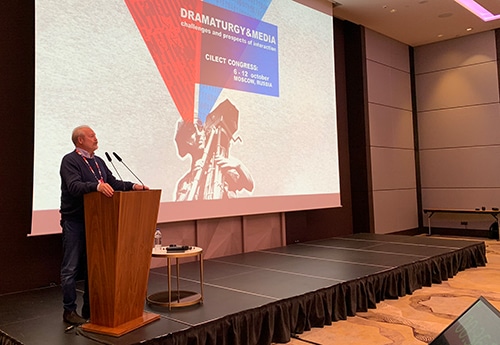 |
| Vladimir Khotinenko given the closing speach of the Congress |
Manovich from New Yok is a theorist who has published several books presented a form of computational methods can be used for the analysis of films by using data science, data visualization and on and on in search of a common world media culture. Vladimir Khotinenko VGIK professor stated that very recently “the shooting process was a cumbersome and elitist occupation; within the advents of gadgets the procedure has become so «democratic» that it now threatens to eliminate the boundaries between amateur and professional filmmaking. Today EVERYTHING is cinema and cinema is EVERYWHERE. It is the next to impossible to predict the consequences of the radical changes in film production and film screening. But we have no right to disregard these new “rules of the game”. As the industry advances in new forms also perception and practice follows new paths. Perhaps Walter Benjamin the German philosopher and essayist was all the way right when he quoted “The illiterate of the future will not be the man who cannot read the alphabet, but the one who cannot take a photograph” One step ahead took Karen Palmer artist from UK, who says that the excessive information have divided society as never before. In her presentation Karen talked about her essay film Riot & Perception an experience of the player facing his own acts and attitudes. An essay of Artificial Intelligence. In the CILECT Booklet says« her latest project Perception Input Output Exploring the intersection of AI, neuroscience, behavioural psychology, film, facial emotion detection, eye tracking, bias and social justice this immersive storytelling experience reveals how a person’s gaze and emotions influence their perception of reality.»….«How comfortable are you with the idea that your perceptions of reality have real-life consequences? Are you ready?»
 A visit VGIK – 100th anniversary.
A visit VGIK – 100th anniversary.
VGIK opened on 1st of September of 1919. Two years after the October Revolution that installed the communist regime in Russia. The school’s first principal was Vladimir Garden a Russian actor who was joined by Lev Kuleshov who have introduced significant studies to the perception of cinema. The history of VGIK is inseparable from the history of cinema. Names like Vsevolod Pudovkin, Sergey Eisenstein, Andrei Tarkowski, Nikita Mikhalkov just to mention a few have contributed for the history and development of cinema as we know today.
VGIK today is a national multi-discipline institution of graduate and post-graduate education. It trains highly qualified staff for film industry, television
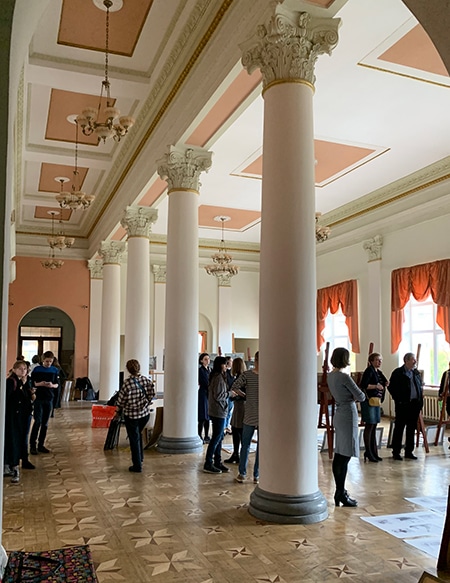 |
| The center hall of the old building |
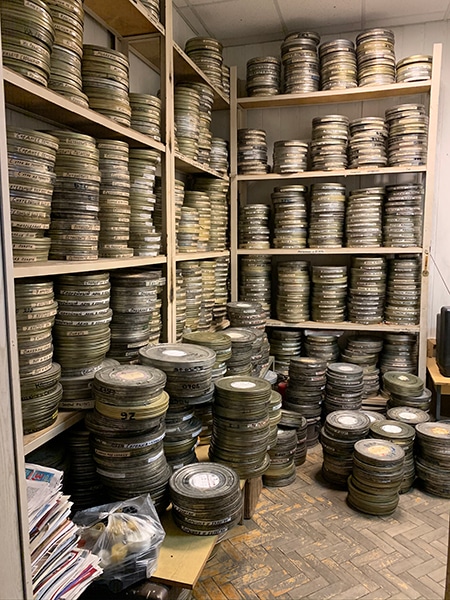 |
| The room where film rolls from historical movies are archived. Students watch films projected in their original format |
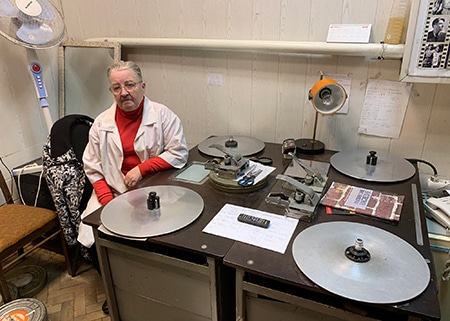 |
| Lady in her place to ensemble the different rolls for projection. |
 |
The VGIK Museum celebrating 100 years. The museum depicts
|
 |
| In the hallway there is plaque remembering the 21 VGIK students and teachers perished during World War II |
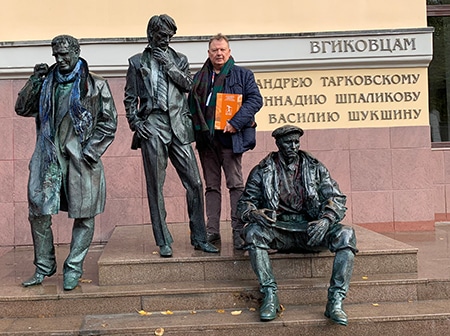 |
| A tourist photo oblige at the monument to Soviet filmmakers Gennady Shpalikov, Andrey Tarkovsky and Vasily Shukshin at the school entrance |
and other visual media at seven Departments: Acting, Directing, Screenwriting and Cinema Studies, Cinematography, Animation and Multimedia, Producing and Management, Production Design.
The students receive a higher professional education, the duration of the course varying from 4 to 6 years. Those having the Bachelor degree can take Master program at Screenwriting Department. VGIK is famous for its system of workshops; it has become a practical system of education allowing constant personal contacts and collaboration with the master-head of a workshop who supervises the student practical work.
VGIK has special programs in different aspects of film training. Since 2009 annually VGIK holds International Summer School where foreign filmmakers cooperate with VGIK students on shooting films at Documentary and Animation sections.
I had the privilege to have a tour in such a famous school with the guidance of Tatiana Tursonova responsible for the International Affairs of the school and also for the summer school recently created by VGIK.
To walk through these corridors is a kind of magical process. An memorial place where real facts happened in history. It is like going to an historical site where something very important have happened that has changed the course of humanity. The same feeling I felt when crossing the corridors seeing the gallery of many men who have written such an important page in film history as we all know since our early studies.
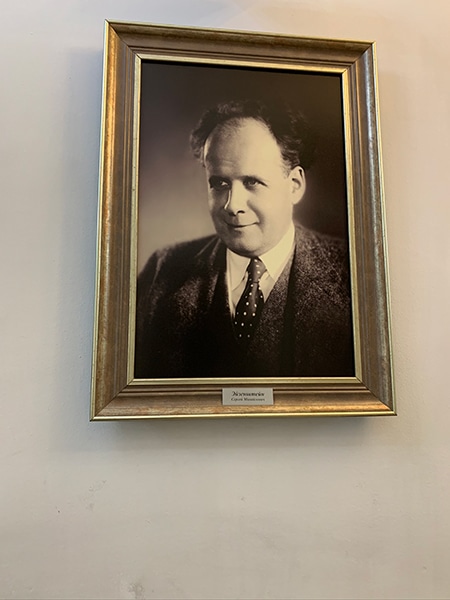 |
| Sergei Eisenstein, director of iconic films such: Battleship Potemkin; Ivan the Terrible; Strike. He was also a theorist he has developed the so called “methods of montage” Metric, Rhythmic, Tonal, Overtonal and Intellectual. |
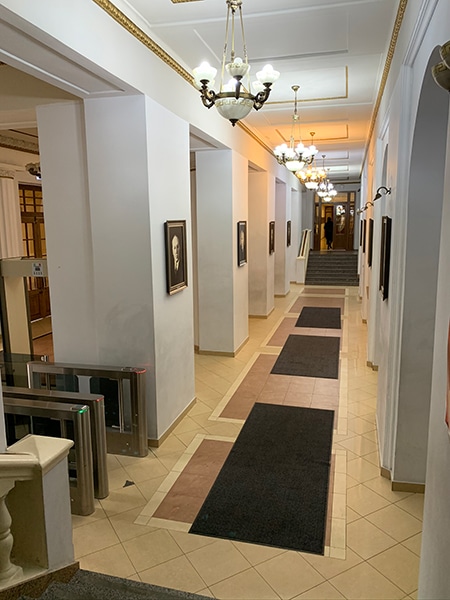 |
| The long corridor of the old part of the school with pictures hanging with the schools most important teachers and students who made history. |
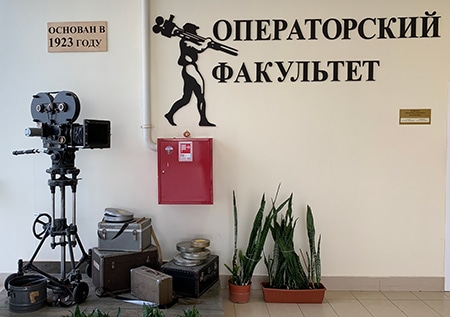 |
| The cinematographer department sits on the 7th floor of the new building of the school. |
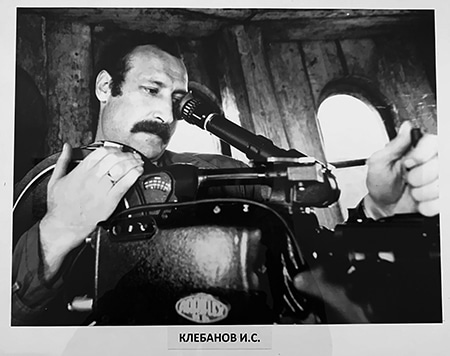 |
| Photograph on the walls of the VGIK cinematography department of Igor Klebanov RGC a long time IMAGO friend. He was also at the CILECT Congress |
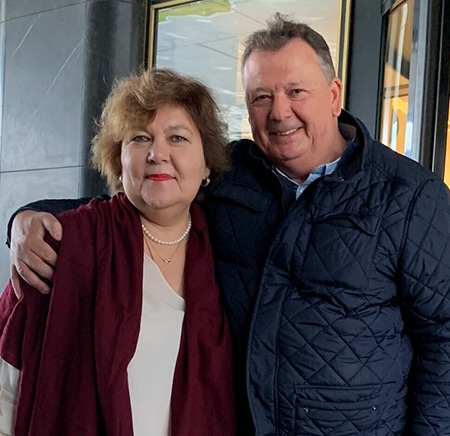 |
| Tatiana Tursonova VGIK international relations was the best guide |
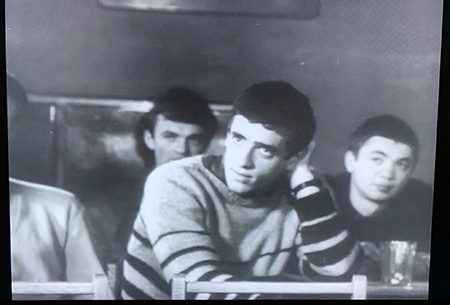 |
| An old documentary footage was passing in a loop in the museum in a Tv screen and we found our good find a very young Yuri Neyman on right side of the picture. He is now the director of the Cinematography Global Institute in Los Angeles a school which founded with late Vilmos Zsigmond. |
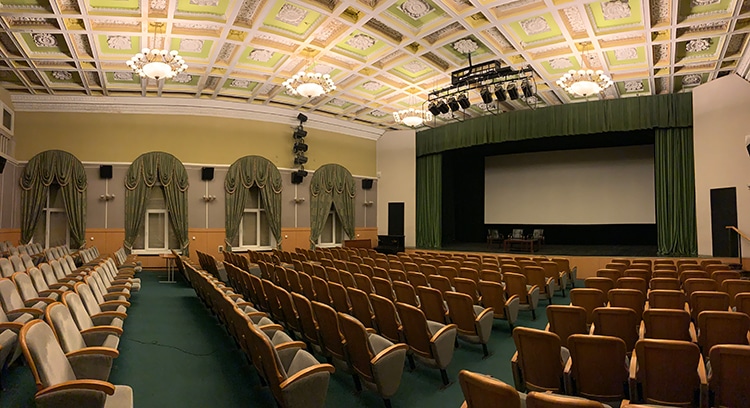 The beatiful cinema preserving its original style
The beatiful cinema preserving its original style

















